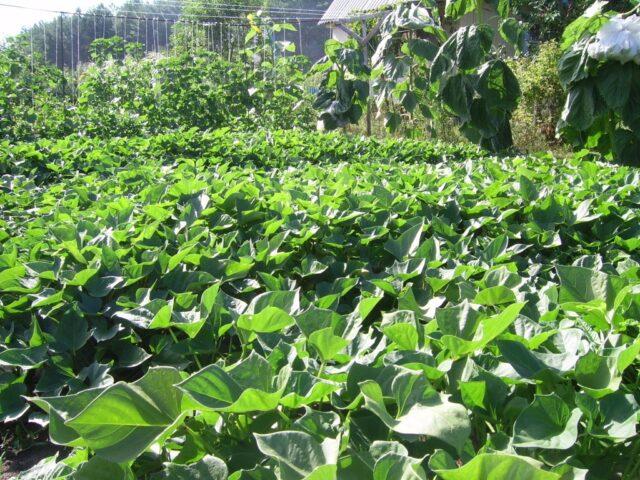Content
You can grow sweet potatoes in almost any region of Russia. The culture is unpretentious and grows on different types of soil, including depleted ones. But at the same time it needs regular watering and fertilizing. Sweet potatoes are heat-loving, so in temperate climates they are grown exclusively by seedlings. Seedlings are most often grown from tubers, but this can also be done by sowing seeds.
Where do sweet potatoes grow in Russia?
Sweet potatoes are sometimes called sweet potatoes, although the plant actually belongs to a different family, the Convolvulaceae. It forms vines on which tubers grow that resemble potatoes in appearance. But they differ greatly in taste - the flesh is always sweetish. Sweet potatoes are not common in Russia because they grow only in warm conditions.
However, it is possible to grow sweet potatoes in the garden in the summer in almost all regions. It is even produced on an industrial scale in farms located in the Primorsky Territory, the Republic of Bashkortostan and Khakassia.
Since the growing season is quite long, and the warm season is not enough, the agricultural technology for growing sweet potatoes involves obtaining seedlings and then replanting them in open ground. With this method, it is possible to obtain a harvest within four months after transferring the seedlings to the site.
When and how to plant sweet potatoes for seedlings
There are two ways to germinate sweet potatoes – from seeds and from tubers. In the first case, new plants may appear that differ from their parents. In the second, 100% identical crops grow that have identical genes. Both options are described below.

The main way to grow sweet potatoes is vegetatively from tubers.
Seeds
This is not the most common way to grow crops. It is more labor-intensive than propagating sweet potatoes by tubers. In addition, it is not always possible to obtain your own seeds - in temperate latitudes they do not have time to ripen. Another limitation is that plants from seeds may differ from their predecessors due to gene recombination.
Typically, the seed growing method is used to obtain new varieties. Work begins at the end of January, the deadline is in the first ten days of February. Seedlings do not grow so quickly, and besides, they can only be replanted at the end of May, when it becomes steadily warm outside.
To successfully propagate sweet potatoes by seeds, it is recommended to act as follows:
- Pre-soak the planting material in warm water for two days, adding a solution of a growth stimulator, for example, Epin, Zircon or Heteroauxin.
- Treat with potassium permanganate, Fundazole or another fungicide in a bright pink solution.
- For successful cultivation, prepare fertile soil by making a mixture based on turf soil, humus, black peat and sand in a ratio of 2:1:1:1.It is also first disinfected in potassium permanganate or calcined in the oven at a temperature of 120 degrees for 20 minutes.
- To properly grow sweet potatoes at home, you need to put the soil in fairly large pots with a diameter of 20-25 cm.
- Seeds are planted to a depth of 2 cm and sprinkled with soil.
- Place on the windowsill in a place at room temperature.
- Spray with settled water from a spray bottle.
- Cover with a film with holes, remove it periodically for ventilation and watering.
- Two weeks before transplanting, take them out onto the balcony or outside so that the seedlings harden.
Tubers
For successful cultivation in the garden, you can plant sweet potatoes from a tuber. It is better to start work at the beginning or in the first half of March. The method is convenient in that it allows you to make up for lost time if the time for planting seeds has already passed. Growing from a tuber is easier to implement, and the resulting plants will fully retain the characteristics of their parents.

To increase the number of cuttings, the tubers can be cut into two parts
The sequence of actions is as follows:
- Make up a soil mixture and disinfect it in the same way as in the previous case.
- Immerse the tuber in the substrate, deepening it a few centimeters. Sprinkle with soil.
- Place on the windowsill at room temperature.
- Moisturize regularly.
- Two weeks before transplanting into the ground, begin hardening.
There are other ways to grow sweet potatoes. The tubers are immersed in a glass of settled water (there should be only 1-2 cm on top of it). Periodically change the liquid and wait for the roots to appear. After the onset of heat (May) they are transplanted into the ground.
Another growing method is to cut the tuber in half and germinate it first on a napkin moistened with water, then transfer it to a pot, and only then transplant it into open ground. Thanks to this, you can get twice as many cuttings with the same amount of planting material.
You can determine the readiness of a sweet potato cutting for transplanting into the ground by several signs:
- length not less than 15 cm;
- number of internodes – at least 5;
- leaves – also at least 5;
- healthy appearance.
It is worth paying attention to the appearance - the tuber must be healthy, not softened, without traces of rot and other diseases. You need to start growing a few weeks earlier, i.e. in mid-February.
How to plant sweet potato seedlings in open ground
To properly grow sweet potatoes in the Moscow region, the middle zone and other regions of Russia, it is necessary to accurately determine the timing of transplantation, prepare the site in advance, and also organize normal care. The basic rules and advice from experienced summer residents are described below.
Disembarkation dates
The timing of transplanting seedlings obtained from seeds or tubers must be planned so that the return frosts have definitely passed. The main criterion is that during the day the temperature stays above 23-24 degrees, and at night it does not drop below +15. As a rule, such weather occurs in Russia only at the end of May or even at the beginning of June.

For successful cultivation, sweet potatoes are planted no earlier than mid-May.
Specific dates depend on the climatic characteristics of the region:
- In the middle zone, including the Moscow region, transplanting to a site is carried out in the last days of spring.
- In the south, you can start work on the May holidays or closer to the middle of the month.
- For cultivation in the Leningrad region and other regions of the North-West, sweet potatoes should be replanted at the end of May or at the beginning of June.
- In the Urals and Siberia, it is better to play it safe and start growing on the plot only in the first half of June.
You can start replanting provided that the temperature of the surface soil layer is at least +18.
Site selection
Sweet potatoes can grow even on depleted soil, but it is best to grow them in light, fertile loam with a neutral reaction. A very important requirement is maximum illumination of the area, even without partial shade. The place should be located on a slight hill. Lowlands are excluded because water accumulates in them. Also, the bed should be spacious, since the minimum spacing between plants is 40 cm.
It is not recommended to grow sweet potatoes in the same place for more than three years in a row.
Soil preparation
The soil for growing sweet potatoes must be prepared in advance. The field is dug up 1-2 months before transplanting, at the same time compost or humus is added at a rate of 5-7 kg per square meter. If the soil is too dense, add 2-3 kg of sand or sawdust to the same area, and if necessary, a little more.
Sweet Potato Planting Scheme
The landing algorithm is as follows:
- Form several rows with an interval of 80-100 cm.
- Mark the ridges and plant sprouted tubers or seedlings in them at intervals of 40 cm.
- Sprinkle with soil.
- Water with settled water and complex fertilizer.
Along with the standard scheme, you can use others - 75 * 50 cm or 100 * 35 cm.

The crop is grown in rows with an interval of 80-100 cm
Caring for sweet potatoes in open ground
When cultivating sweet potatoes in open ground, it is necessary to take care of both proper planting and plant care. The basic rules are regular watering and periodic fertilizing. Despite the fact that biologically these are not potatoes, the cultivation technology is approximately the same. In both cases, it is necessary to carry out hilling and weeding.
Plants are periodically inspected and, if necessary, treated against diseases and pests. This helps in cultivation and ensures a good harvest.
Top dressing
Sweet potatoes actively feed on microelements, so fertilizers should be applied regularly. For proper cultivation, they are given every 2-3 weeks, alternating complex mineral compositions with liquid organic matter, for example, potassium humate, mullein infusion 1:10 or chicken manure 1:20. Sometimes you can add wood ash no more than 250 g per 1 m2. If you add it in excess quantities, the soil may become alkaline, which will adversely affect its fertility.
Watering
When growing sweet potatoes, watering is especially often given in the first month after transplantation - 2-3 times a week. Over time, water less frequently - weekly. If there is rain, additional moisture is not needed. They completely stop giving water two weeks before harvesting. The water must be pre-settled. It is poured into containers and left under the sun or indoors.

If you water sweet potatoes regularly during cultivation, the yield will be high.
Hilling
Hilling and loosening for proper cultivation of sweet potatoes is carried out at intervals of 3-4 weeks. The procedure is simple - the soil is loosened to a depth of 5-7 cm and sprinkled around the bush to create a small bank. Since sweet potato vines grow well when grown properly, row spacing should not be allowed to overlap. If you do not lift the stems, they will take root at the nodes, and the yield will decrease because of this.
Diseases and pests
When growing sweet potatoes, they must be protected from leaf rot, tubers, powdery mildew and other fungal infections. For prevention, follow the watering norm and periodically loosen the soil. If necessary, treat with Bordeaux mixture or other fungicides.
Of the pests, slugs, mole crickets, and wireworms pose a particular danger to sweet potato cultivation. They fight them in different ways. Insecticides are used against insects and ticks, for example, Biotlin, Fufanon or Aktaru. To repel slugs, scatter the following around the garden bed:
- mustard powder;
- ground red pepper;
- nut shells or eggs.
Also, when growing sweet potatoes, you can use special preparations to repel slugs, for example, “Thunderstorm” or “Ulitsid”. These are effective remedies that must be used according to the instructions so as not to exceed the maximum dosage.
Conclusion
You can grow sweet potatoes in most Russian regions. In this case, the tubers should initially be sprouted at home. Work begins in early March, and in the case of seeds - a month earlier. The resulting seedlings are transferred to open ground no earlier than mid-May.








